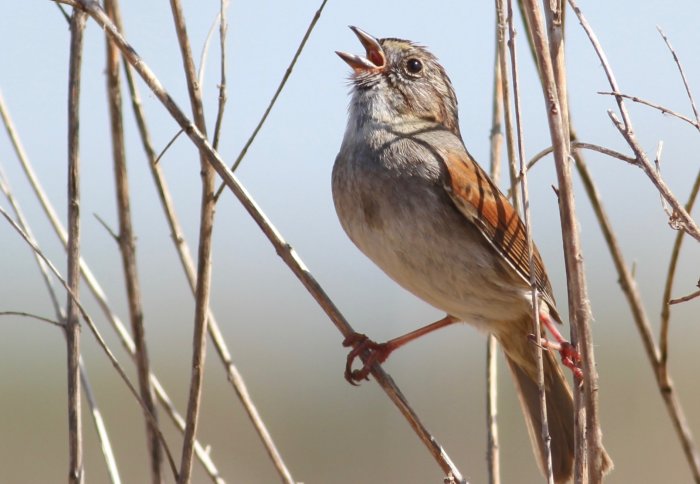Stubborn sparrows may have sung the same songs for hundreds of years

By preserving songs for centuries, American swamp sparrows show a cultural stability previously only seen in humans.
Local populations of birds may have sung the same songs for hundreds of years and passed them on through the generations, according to researchers at Imperial College London, Queen Mary University of London and Duke University.
The song types that you could hear today in the marshes of north-eastern USA may well have been there 1,000 years ago and have been precisely passed on from one generation to the next, rivalling the stability of human cultural traditions. Dr Robert Lachlan
The study, published today in Nature Communications, demonstrates that birds are capable of matching and potentially exceeding the stability of human cultural traditions - despite their much smaller brains.
The researchers were able to estimate that the swamp sparrows (Melospiza georgiana), a well-studied species of songbird from the marshes of north-eastern USA, accurately learn their songs 98 per cent of the time, making them excellent copycats.
More surprisingly, they do not pick songs to learn at random from those that they hear. Instead, they selectively choose songs that are more common - a learning strategy called conformist bias, which was recently thought to be exclusive to humans.
Conformist bias has the effect of filtering out most new song types from the population as soon as they arise, making the song traditions of swamp sparrows very stable.
Listen above to the researchers talking about their findings (or listen to the whole interview on the Imperial College Podcast)
Long-lasting traditions
Lead author Dr Robert Lachlan, from Queen Mary’s School of Biological and Chemical Sciences, said: “It is well known that many species of birds learn their songs from other members of their species. In humans, such vocal learning leads to large communities of people sharing the same dialect, and learning in general leads to long-lasting traditions, through processes of cultural evolution.
“We demonstrate that a fairly humble songbird species can generate stable cultural traditions. The song types that you could hear today in the marshes of north-eastern USA may well have been there 1,000 years ago and have been precisely passed on from one generation to the next, rivalling the stability of human cultural traditions.”
The research team recorded the song repertoires of 615 male swamp sparrows in six populations across north-eastern USA that had locally distinct song types. They then used computational methods to measure the diversity of different song types found in each population.

Study co-author Dr Oliver Ratmann, from the Department of Mathematics at Imperial, said: “One of our innovations was to compare the output of simulation models of cultural evolution to the recorded bird songs.
“First, we broke down songs into syllables to characterise the song repertoire of each sparrow that we recorded. We then calculated how closely our observations matched our mathematical simulations in terms of syllables. We repeated this process many times, allowing us to infer the learning strategies that were most compatible with the data.”
Young birds might prefer to imitate one particular adult, such as their dad or a male with a good territory. Alternately, they might pick certain songs because they find them inherently more attractive, regardless of who sings them.
When the team looked at how well their simulations fit the real data, they found that young birds copy the crowd, mimicking the most popular songs more often than one would expect by chance.
New methods for tracking evolution
The analysis also shows that birds do not need to keep track of how many birds are singing each song to figure out how to fit in. They memorize a variety of songs early in life, from multiple older birds, but once they reach adulthood they only keep the songs they repeatedly hear others singing.
It is fascinating to see that the method is now so widely used that it even allows us to gain new insights into something as complex as language and the evolution of cultural traditions. Dr Oliver Ratmann
The computational method, called Approximate Bayesian Computation, is a relatively new invention in mathematics, but has previously been applied to the evolution of fruit flies, humans and flu. Dr Ratmann added: “It is fascinating to see that the method is now so widely used that it even allows us to gain new insights into something as complex as language and the evolution of cultural traditions. It enabled us to test our intuition that a relatively simple learning behaviour, which our tiny birds were capable of, may generate remarkably stable song traditions.”
Study co-author Professor Stephen Nowicki, from Duke University, said: “The longstanding stable traditions so characteristic of human behaviour have often been ascribed to the high cognitive abilities of humans and our ancestors. But what we’re showing is that a relatively simple set of rules that these songbirds are capable of following can achieve equally lasting traditions.”
-
‘Cultural conformity generates extremely stable traditions in bird song’ by Robert F. Lachlan, Oliver Ratmann and Stephen Nowicki is published in Nature Communications.
-
Image credits: Robert Lachlan
Article text (excluding photos or graphics) © Imperial College London.
Photos and graphics subject to third party copyright used with permission or © Imperial College London.
Reporter
Hayley Dunning
Communications Division